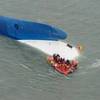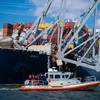A Remotely Piloted Surface Vessel (RPSV) will be unveiled at the Navy League Air Sea and Space Exhibition Washington DC 26-28 March 2002 by Boston Whaler Commercial and Government Products Inc, a Brunswick Corporation boatbuilding division.
Developed jointly by Boston Whaler, Global Atlantic Inc. and Smart boat Inc., the 15 foot fiberglass hull of the RPSV is propelled by a 2.5 litre V6 cylinder 175hp Mercury SportJet water jet giving a speed capability in excess of 40 knots. Although initially
offered with a gasoline engine, a diesel or multi-fuel variant will be optional in the near future.
Selection of Boston Whaler as lead contractor to supply the boat hull was made due to its long reputation as volume manufacturer of hulls with proven sea-keeping qualities and its experience in governmental and military boats. General Manager Eric Caplan said, "this cost-effective RPSV brings about a quantum leap in naval/marine tactics, heralding a new era in maritime security."
The RPSV operates without a pilot and is controlled either remotely or autonomously according to mission and set-up. Typical tasks for this craft are surveillance and interdiction: able to operate for periods ranging from several hours to several days, depending on fuel limitations. The RPSV can remain on-station for long periods: the GPS navigational system linked to electronic chart software gives the platform a waypoint route or search pattern navigational capability.
Propulsion and steering control functions use a customised Mercury SmartCraft CAN-bus network, integrated to the "black boxes" of the command and control system specially developed for the application. The on-board computer is a COTS design with open architecture, retained in special marine shock mounts. Optional equipment includes a revolutionary gyro-stabiliser, reducing roll of the vessel by up to 70 per cent, video telemetry, RF, VHF, satellite or cell-phone telemetry over a digital link. High-definition video with low light capability, infrared camera, spot/floodlights, electric thrusters providing position loitering. Additional roles could include port and coastal security, mine detection and neutralisation, fire fighting and observation - putting a robot in harms way where you don't want to risk human life.
Further capabilities of the RPSV may be enhanced by the addition of sensors to monitor Chemical Biological Radiological (CBR) contaminants or oil pollutants, mapping of the sea bottom and searching for underwater objects on and below the sea floor. Final specification of the RPSV and equipment will usually be made in consultation with the client following a comprehensive Mission and Field Analysis.
Sponsored Content
Chris-Marine’s solutions help to prolong engine lifetime

AST is now AST Networks, bringing you remote connectivity wherever you are

March 2024
 Read the Magazine
Read the Magazine

 Read the Magazine
Read the Magazine
This issue sponsored by:

New Orleans is Sinking, and it is Not Tragically Hip
March 2024
 Read the Magazine
Read the Magazine

 Read the Magazine
Read the Magazine
This issue sponsored by:

Preparing for Change, ABS Enhances the Marine Vessels Rules Book
Subscribe for
Maritime Reporter E-News
Maritime Reporter E-News is the maritime industry's largest circulation and most authoritative ENews Service, delivered to your Email five times per week










